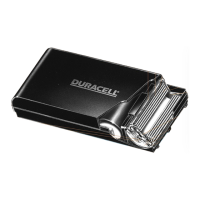
Do you have a question about the Duracell Ni-MH and is the answer not in the manual?
| Brand | Duracell |
|---|---|
| Model | Ni-MH |
| Category | Camera Accessories |
| Language | English |
Details the materials used in the positive and negative electrodes of Ni-MH batteries, focusing on the hydrogen storage alloy.
Describes the electrolyte composition, primarily potassium hydroxide, and its role in the sealed cell design.
Explains the chemical reactions occurring during discharge and charge, including the oxygen recombination mechanism.
Explains the design of electrodes in cylindrical and prismatic cells, focusing on porous structures for high surface area.
Details the assembly of a cylindrical Ni-MH cell, including electrode winding, separator, electrolyte, and sealing.
Describes the construction of prismatic Ni-MH cells, highlighting differences from cylindrical cells and volumetric energy density benefits.
Compares Ni-MH and Ni-Cd cell characteristics, voltage profiles, and capacity advantages of Ni-MH.
Discusses typical discharge curves for Ni-MH batteries under varying current loads and temperatures.
Explains how discharge current and temperature affect battery capacity, and the recommended cutoff voltage.
Defines energy density and compares gravimetric and volumetric energy density of Ni-MH vs. Ni-Cd batteries.
Shows output energy characteristics under constant power discharge at different power levels.
Explains the risks of polarity reversal in series connections and how to prevent it.
Discusses low internal impedance of Ni-MH batteries and how it changes with depth of discharge.
Covers self-discharge mechanisms and capacity retention of Ni-MH batteries at different temperatures and storage durations.
Explains voltage depression, often mistaken for memory effect, and how to mitigate it in Ni-MH batteries.
Outlines key criteria for effective charging: rate, temperature, and termination technique.
Discusses various charge control techniques and their impact on capacity, cycle life, and termination.
Explains timed charge control, its limitations, recommended parameters, and backup cutoff.
Describes using voltage plateau (zero △V) for charge termination, its risks, and recommendations.
Details temperature cutoff as a charge control method and its challenges with ambient temperature influence.
Explains Delta Temperature Cutoff (△TCO) for charge termination, its advantages, and recommended parameters.
Discusses dT/dt charge control, its benefits for cycle life, and recommended settings.
Introduces various charging methods for Ni-MH batteries, noting differences from Ni-Cd and mentioning a three-step procedure.
Details Duracell's recommended three-step charging procedure for fast charging and optimal performance.
Describes low-rate charging using time-limited termination, its convenience, and temperature range.
Explains quick charging methods, required charge control, and backup termination for safety.
Covers fast charging at C/2 to 1C rates, essential early termination, and recommended control methods.
Discusses trickle charging for maintaining a fully charged state and its recommended rate and temperature range.
Details temperature sensing and protective devices (NTC Thermistor, Thermostat, Thermal Fuse, PTC) used in Ni-MH batteries.
Explains factors affecting cycle life, such as temperature, charge/discharge rate, depth, and storage.
Covers overall battery life, factors reducing it, and recommended/permissible temperature limits for operation and storage.
Covers battery disassembly, handling, fire risks, vented compartments, and severe use applications.
Provides information on regulations for transporting batteries by air and other modes.
Details recommended practices for recycling and disposing of used Ni-MH batteries, including household and commercial use.
